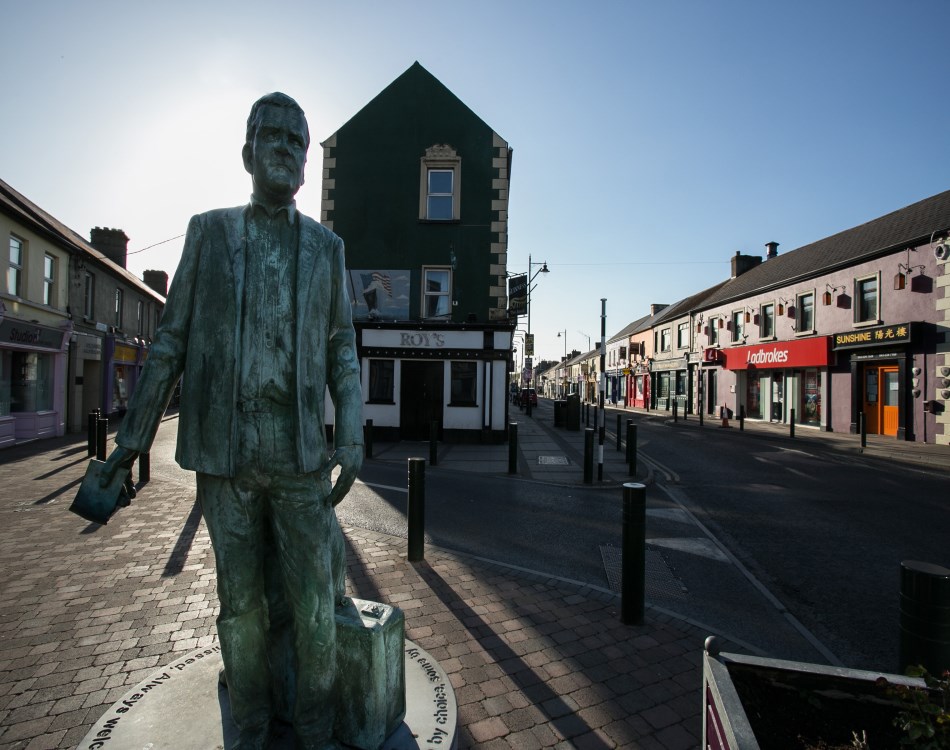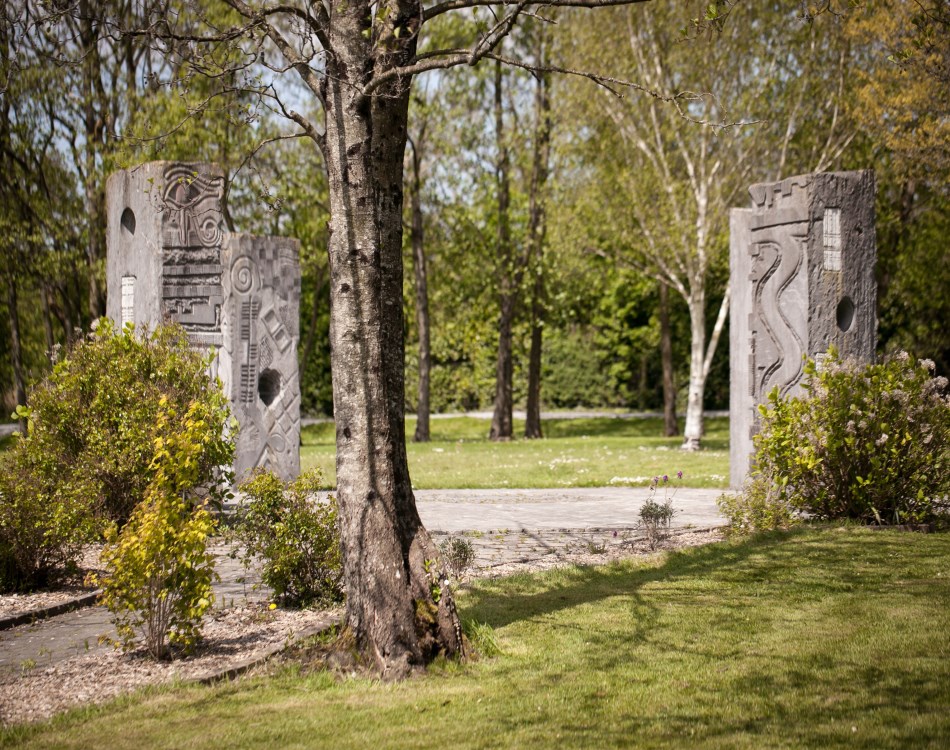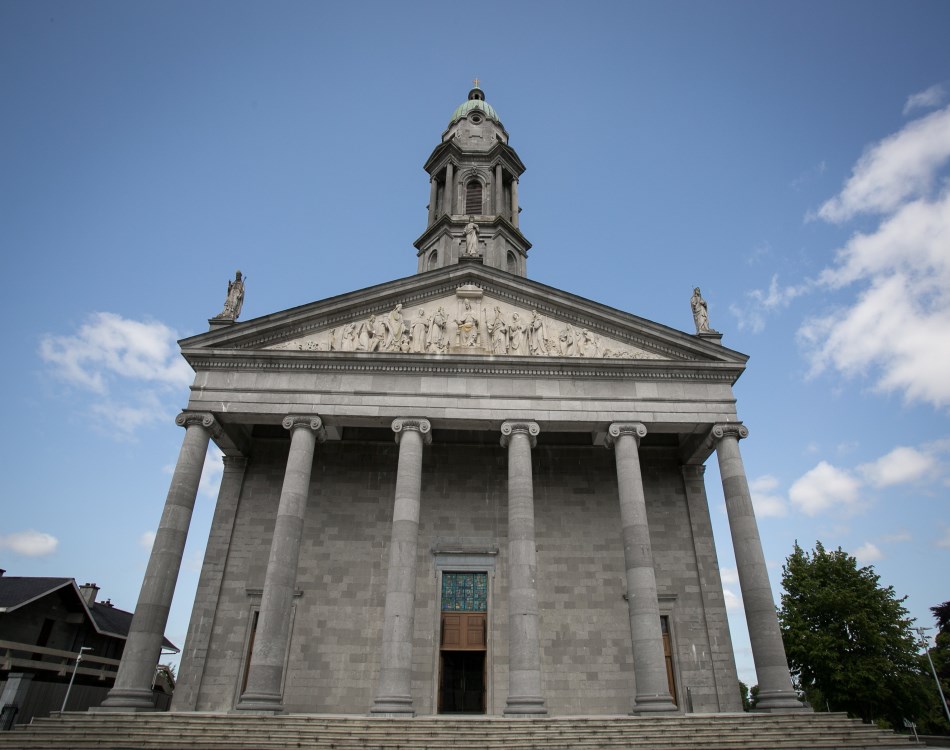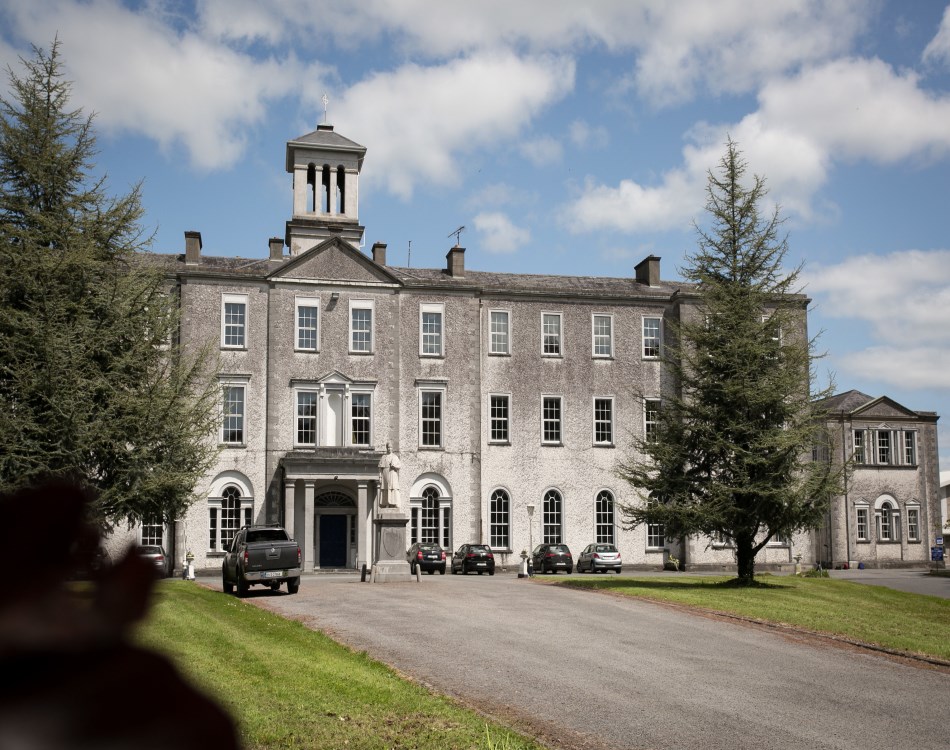Longford

Longford town is situated in the heart of Ireland, on the south bank of the river Camlin and on the main Dublin to Sligo road. It is a progressive town and the County administrative centre. It is also a convenient cross-roads for Belfast, Mayo, Galway or Limerick routes and is ideally placed as a tourist centre for the Lakeland District of Irelands Midlands and the beautiful Shannon River.
There is much to attract the tourist to Longford. A Cathedral town, it is the seat of the Bishop of Ardagh and Clonmacnoise. Saint Mels Cathedral and Saint Johns Church, both dating from the 19th Century, stand at the East and West entrances to the town. The visitor is well catered for in Longford with activities to suit all tastes.
The town is spaciously laid out with wide streets and pleasant buildings, and recent impressive urban development. It is a good shopping centre. The dome of the 19th Century St. Mels Cathedral, a renaissance style building of grey limestone with a lofty steeple, may be seen from quite a long way from outside the town. On Christmas morning 2009 the people of Longford were shocked and bereft to discover that a devastating fire, due to a malfunction in the heating system, had ripped through our beloved Cathedral leaving only the exterior walls, portico and campanile standing. A swift response to the disaster saw the Saint Mels Project Committee formed, to take on the task of rebuilding the Cathedral, an enormous and daunting restoration project given the economic crisis the country was experiencing.
This multi million project was the biggest restoration project in Europe at the time with the finished building being an awe inspiring display of craftsmanship, dedication and love. The official re opening of St Mels Cathedral took place at Christmas 2014, when the newly restored Cathedral was finally unveiled to the public. It has been dubbed ‘The Longford Phoenix’ following its spectacular rise from the ashes of Christmas 2009.
Longford courthouse is the oldest building in the town and was built on the main street in 1793, probably on the site of an earlier building. The architect is unknown. Steps lead to a Doric entrance door-case with a central first floor Venetian window above. The building was finished generally in plain lime render with limestone dressings to the windows, which were probably altered in 1859 to 1860 to sliding sash windows.
The Mall is a beautifully landscaped park on the banks of the River Camlin. This park is ideal for picnics, walks or sporting activities.

Albert Reynolds Peace Park (also known as The Mall) in Longford Town
History of Longford Town
The town received its name from the ancient castle of the O'Farrells, Prince of Annally, who also in 1400, founded a Dominican priory here. No trace of either building has survived, but there are fragmentary remains of the castle erected in 1627 by the first Earl of Longford. During the Confederate wars of 1641 this castle was captured by the English and later withstood a siege of several weeks by Owen Roe ONeill. Longford Town sprung up along the banks of the river Camlin. Its strategic midland location saw it develop as a gateway to the northwest and the northern half of Connaught. Furthermore this important location was recognised as early as the 1700s when the British authorities sited both a cavalry and artillery barracks in the town. The present Great Water Street was the main centre of commerce and industry for much of the last century. Buildings of importance surviving from this era include St John’s Church of Ireland 1760, Longford Court House and the Longford Arms Hotel 1807. With the arrival of the Royal Canal in 1830 and the railway in 1855, the eastern side of town slowly became the main centre of commerce and industry. The National Bank was set up in 1834, St Mel’s Cathedral in 1840 and the (former) Garda Station circa 1842. In more recent times there has been the development of Earl Street while the arrival of the shopping centres has re-kindled the central part of the town. Since the 1960s Longford has developed rapidly as a centre of excellence both in manufacturing and retailing. The rapid urbanisation of Irish society is reflected in the growing town population, which is well served by some of the finest leisure and recreational facilities in the country.
Main Street
As you cross the bridge from Church Street and travel into Main Street, notice the pleasant three-storey building with a coach arch and pedimented door and windows. This building was once a Gentleman’s Club and is now used as a business premises.
Battery Road
Travelling from Sligo you first encounter the Battery Road, a broad tree lined avenue with the houses on the right set back off the road. Built for British Army Officers these large paddocks were intended as a grazing area for their horses.
Great Water Street
After the Industrial Revolution in England, Longford had a significant share of industry, much of which was concentrated in the Great Water Street area. There were a large number of businesses here dating from the early 1800s which included a Fowl Market (on the site now occupied by the new Council Offices), a Butter Market, Longford Gas Works (formed in 1857), a Bonded Warehouse, a Pottery and Lime Kiln, Corn Mill, Timber Mill, Distillery (which produced 5,000 gallons of whiskey annually), Flax Mill and a Tannery and Abattoir. Opposite the Fowl Market there was a school catering for young girls, which still stands today, but is now a private residence.
St Mel's Road
If you journey past the Cathedral you will find a quaint unique Victorian style street. The houses of St Mel’s road have the distinction of being built with stones from the old jail on the Battery Road.
Things to See & Do in Longford
St. Mel's Cathedral

St. Mel’s Cathedral was erected in the 19th century. The foundation stone was laid by Dr. Higgins, the Bishop of Ardagh and Clonmacnois on 19th May 1840 and completed on 29th September 1856 by the Right Rev. John Kilduff, his successor. The building was destroyed by fire in 2009 but was completely refurbished and re-opened at Christmas 2014. Further information at https://www.churchservices.tv/stmelscathedral.
St. Mel’s College
Most Rev. Dr. Kilduff issued the first appeal on 11th November 1861, for funds to build a Diocesan seminary, not merely for clerical students but also for all who desired a secondary education for the secular career to which they might choose to devote themselves. This was the first mention of St. Mel’s College which was completed and officially opened to students in 1865. The college is still functioning as a secondary level boys school in the town.
The Methodist Church
This church was opened to worship in 1895, also a Baronite meeting-house with a national school for each persuasion, also a Presbyterian church. The present Methodist Church was built in 1895. It replaced an earlier Baronite Meeting House and school in use in Richmond Street and prior to 1895, it was visited by Methodist founder John Wesley. The school was situated on lower Richmond Street, while the church was a portion of an adjoining premesis.
The Market Square
A far back as the 1800's traders brought corn, potatoes and pigs etc here for sale. An old market house, now demolished, was used to store these goods. The square is still used as a market with a variety of fresh fruit and vegetables sold from stalls every Friday. At the front of the square is a Celtic Cross memorial dedicated to the men who died in the First World War.
Walking Tour of Longford

Longford town is situated in the heart of Ireland, and like so many towns, it has sprung up along the banks of a river, in this case the river Camlin. It is one of the main towns situated on the Dublin to Sligo road. It is a vibrant town of traditional and modern commercial activities. The town hosts many fine buildings and places of historic and scenic interest. We hope that with the aid of this walking tour you will enjoy the many attractions which Longford has to offer. This walking tour was compiled by the TY Students ‘03, Scoil Mhuire in conjunction with Tourism Studies and Longford Co. Library.
St. Mel’s Cathedral: Situated just off Dublin St. this landmark building of 19th century Renaissance style is built of grey limestone. The stone taken from the original cathedral of St. Mel’s of Ardagh was laid by Bishop O’Higgins in 1840. The main body of the cathedral is Romanesque and was designed by John Benjamin Keane. It has wonderful mosaic floors and arched baroque ceilings. The limestone baptismal font is separate from the main body of the cathedral, to the left, due to its removal earlier in the century. It is available to see by appointment. Among the notable events of the Cathedral was the marriage of General Seán Mac Eoin to Alice Cooney, which was attended by General Micheal Collins and Arthur Griffith in 1921. Its two hundred foot high tower is visible all over Longford.
Courthouse.This is the oldest building in Longford, it was constructed in 1793 replacing the former courthouse situated on the Market Square. Recently renovated, it is a fine building and in its time was one of the first to be slated in Longford. The building is the main courthouse for Co. Longford and had a deep history which included an underground tunnell to the jail on the Battery Road on which prisoners were take on their way to be hung.
The Gentleman’s ClubThis building was once a gentleman’s club and is now used as a business premises (Groarke’s Solicitors). The club, also known as the Co. Longford Club, was founded in the 1890’s and it operated until the 1920’s when it was reconstituted. Its members were made up mainly of successful local shop traders and members of the legal profession. It was established to afford its members “good social intercourse and rational recreation”. Many of its members went on to play a part in founding the local golf club.
The Camlin Bridge.The Camlin Bridge is situated at the upper end of Longford town. It is built of grey limestone and was erected in 1718, rebuilt in 1819 and widened in 1993. The town expands north and south of the bridge. The river Camlin, as the starting point of the town, was of great importance. It provided the townsfolk with water for cooking and cleaning and it was a vital means of transport. The Bridge is dedicated to P.M. Farrell who was a local and very popular solicitor and County Councillor.
5. St. John’s Church.On the corner of the Battery road and Church Street stands St. John’s Church of Ireland. The present building, gothic in design, dates back to the 1700’s. However, in 1812, the church was reconstructed. A list of the rectors of the parish since the late 18th century can be found in the vestry. Silver chalices, donated by the first Earl of Longford in 1699, are still in constant use. Joseph Ward is interred in the graveyard - born in Kinsale, he was one of the first to be awarded the Victoria Cross for distinguished bravery for his part in the Crimean War and Indian Mutiny.
The Mall.The Mall is a beautifully landscaped park on the banks of the River Camlin. Beautiful trees surround the park and a stream filled with fish flows through the heart of the park. This provides an ideal fishing location. Close to the town centre, the mall is a perfect venue for leisurely walks, picnics or sporting activities. The mall boosts an indoor multi-purpose hall and gym, swimming pool, outdoor basketball courts, and an outdoor soccer pitch. A new playground also provides local children with a new amenity. In the grounds of the mall, you will find beautifully crafted millennium stones. These stone structures were erected to commemorate the millennium. Local artist, Gary Robinson designed them and they are well worth a visit. The state of the art new swimming pool and all-weather pitches are also very popular for recreational activities.
St. Mel’s College.Between St. Mel’s Road and the Ballinalee Road lies St. Mel’s College. It opened in September 1868 with 48 boarders and 25 dayboys. It was a major seminary where students pursued courses in philosophy and theology. The avenue of trees was planted during the presidency of Fr. Hoare. He established a system of scholarships of half burses, which increased the student number to 78 in 1897 and later became bishop in 1898. The college was raided by crown forces during the War of Independence and General Seán Mac Eoin was fêted at a banquet held in the College. Over the years, there have been numerous changes have been to the college such as stain glass windows, a new wing, refectory, assembly hall, classrooms and sports hall. In 2000 a €3.5m extension was started and the gymnasium completed. In 2002 the last boarding students departed, ending a tradition which began in 1865.
Padraic Colum and the Old Famine Workhouse.Today St. Joseph’s Hospital stands in the site of what used to be Longford’s Old Famine Workhouse. The workhouse was opened in 1842. It was a home for the homeless downtrodden people. It was here that Longford’s famous poet Padraic Colum was born on the 8th of December 1881. In his poem “The Drover” he talks of Longford “ To Meath of pastures, From wet hills by the sea, through Leitrim and Longford, go my cattle and me”. The workhouse was demolished in 1968 and St. Joseph’s Hospital was built. Today you can see a memorial that was erected to commemorate the people who died in the workhouse and are buried in the famine graveyard. For full breakdown please see Longford Town Walking Trail.



